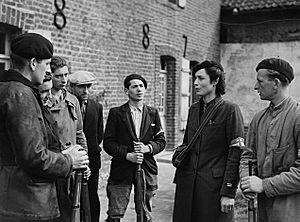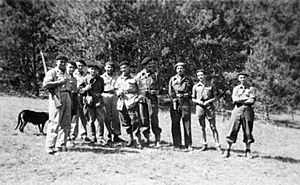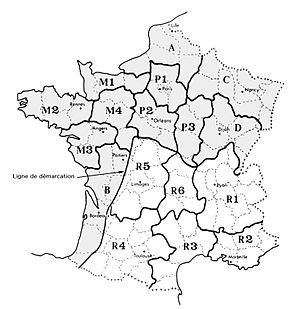Maquis (World War II) facts for kids

The Maquis (pronounced mah-kee) were groups of guerrilla fighters in the countryside of France and Belgium. They fought against the Nazi occupation of France during World War II. These fighters were called maquisards.
Many young men joined the Maquis. They were mostly working-class and had escaped into the mountains and woods. They did this to avoid being forced into the Service du travail obligatoire (STO). This was a "Compulsory Work Service" created by Vichy France. It sent people to work as forced laborers for Germany. To avoid being caught and sent to Germany, these young men became organized into active resistance groups.
By autumn 1943, there were an estimated 25,000 to 40,000 Maquis members. By June 1944, this number grew to about 100,000 members.
| Top - 0-9 A B C D E F G H I J K L M N O P Q R S T U V W X Y Z |
What Does "Maquis" Mean?
The word "Maquis" first came from the type of land where these armed resistance groups hid. This was high ground in southeastern France covered with thick scrub bushes. This scrubland was called maquis.
The word "maquis" means "thicket" or "bush". In Corsica, an island near France, the saying prendre le maquis means "to go into the bush". This describes someone who leaves their village to live hidden in the wild. They might be seeking revenge or trying to avoid being arrested.
The term "maquis" came to mean both the group of fighters and their hidden rural locations. The fighters themselves were called maquisards. They were seen as dedicated and willing fighters. The term became an honorable name for armed resistance fighters.
The Maquis became a symbol of the French Resistance. It described many resistance groups that fought in France before the Allied invasion of Normandy in 1944. After the Allies landed in France, the government of Free France tried to unite these groups. They brought them together under the name French Forces of the Interior (FFI).
The FFI was the national name for all Maquis forces during the war. This large group had about 400,000 active members in 1944. It was divided into three main parts:
- The Francs-Tireurs et Partisans (FTP) was a military group. It was created by and for the French Communist Party.
- The Armée secrète (AS) means "Secret Army". This group was often led by officers from the French army.
- The Organisation de résistance de l'armée (ORA) means "Organisation of army resistance". It was officially started in January 1943. It was a more "official" group for former French military members. They wanted to continue fighting in the Zone libre (the southern half of metropolitan France).
The official French government in Vichy and the German authorities saw all three groups as "terrorists". Some other small local groups did not join these main organizations.
How the Maquis Operated

Most maquisards worked in remote or mountainous areas. These included Brittany and southern France, especially the Alps and Limousin. They used guerrilla tactics to bother the Milice (French police working with the Germans) and German troops.
The Maquis also helped many people escape. These included Allied airmen whose planes had been shot down, Jews, and others chased by the Vichy and German authorities. Maquisards usually needed some help or support from the local people.
In March 1944, the German army started a terror campaign across France. This included attacking and harming civilians in areas where the French resistance was active. Examples include the Oradour-sur-Glane, Maillé, and Tulle massacres by SS troops.
Most Maquis groups, like the Maquis du Limousin or the Maquis du Vercors, took names from the area they were in. The size of these groups varied a lot. Some had only tens of members, while others had thousands of men and women.
Political Views of the Maquis
The Maquis groups included people with many different political beliefs. There were right-wing nationalists, liberals, socialists, communists, and anarchists. Some Maquis groups in southwest France were made up entirely of left-wing Spanish veterans from the Spanish Civil War.
According to historian Matthew Cobb, the Communist Maquis groups fought the Nazis more actively and immediately. Groups linked to Charles de Gaulle were asked to wait for a bigger attack later in the war. Because of this, some maquisards joined Communist groups just to be part of a more active resistance. This was not always because of their political beliefs. Georges Guingouin was a very active Communist Maquis leader.
The British Special Operations Executive (SOE) helped the Maquis groups linked to the Free French. They sent supplies and agents. However, they did not extend this help to the Communist Maquis groups. The American Office of Strategic Services (OSS) also sent its own agents to France. They worked with the SOE and French agents as part of Operation Jedburgh.
The Maquis had many different smaller groups with their own goals and political ideas. In 1944, an OSS agent named Robert R. Kehoe worked with a Maquis group. He said the organization was "fractured," meaning broken into many parts. He noticed that "the various components were quite independent, with members loyal to their own leaders and to the political forces behind them."
For example, Maquis groups in Brittany often did not speak French. They focused on getting German forces out of their own region, not necessarily all of France. Because they were not centrally organized, the Maquis could not achieve as much as the Allied nations had hoped.
How the Maquis Started
Before the Maquis, smaller resistance groups already existed in France. In northern and western France, groups like Organisation civile et militaire and Libération-Nord printed secret newspapers. They aimed to build unity and carry out small actions to annoy the Germans. Some of these groups also started hiding weapons and planning sabotage. In the southern "Free Zone," groups like Combat and Libération-Sud grew larger.
Resistance groups in the occupied zone eventually connected with the Free French in London. They also worked with the Special Operations Executive (SOE), set up by Britain to fight Nazi-occupied Europe. By May 1941, northern groups focused on sabotage and spying. Southern groups focused on planning escape routes. The Front National became the only major movement common to both.
Resistance became closely linked with the effects of the occupation and new laws from the Vichy government. As working-class people became unhappy, "resisters and people on the run could be harboured with a degree of safety" in the rural areas of France. The connection between the Vichy government and armed resistance led to the formation of the Maquis.
The Service du travail obligatoire (STO), or Compulsory Labor Service, started on February 16, 1943. It required young men born between 1920 and 1922 to register at their town halls. The authorities then decided who would work for Germany. In the first few months, many young men refused the STO and went into hiding. They often hid in areas where people were already hiding Jews and other resisters. These early refusals and the small groups that formed helped create the idea of le maquis.
People who hated fascism, immigrant workers on the run, and veterans of the Spanish Civil War joined these groups. The Vichy government was also not very strict in chasing those who refused the STO. All these factors helped a strong movement grow. The idea of "maquis" spread very quickly. It did not exist in January 1943, but by June, people were talking about the maquis all over France. The Maquis eventually became a national service because so many young people joined to protest the STO.
The Maquis's Role
The Maquis de l'Ain, led by Henri Petit, set up a network of camps. These were in the thick forests of the mountainous Bugey region. They did not create fixed camps. Instead, they chose places that were isolated but also allowed for quick escapes. The enemy could not easily surprise the maquisards because they had wide views from the hills. However, some groups stayed in the same spots for months, even though their own rules said they should move often.
The Maquis used guerrilla warfare. This "created a fear within the enemy," making them seem stronger and more numerous than they were. The Maquis de l'Ain became very effective after opening a training school in June 1943. Captain Romans explained their rules:
The watchwords were explicit: no large concentrations of men. No pitched battles. Guerrilla warfare only! We had a few revolvers and some hunting rifles and were reduced to making sketches in order to teach the use of modern weapons. Early in July we received our first Sten machine gun. We kept taking it apart and putting it together until we could do it in record time, Then the gun was passed from one camp to another.
The Maquis's goal was to weaken the Vichy government's power. They did this by making both themselves and the Vichy authorities the "hunters" and the "hunted."
During the Allied invasion of Normandy, the Maquis and other groups helped delay the German army. The French Resistance (FFI) blew up railroad tracks. They also attacked German Army equipment and trains heading to the Atlantic coast. Secret messages on BBC radio warned the Maquis about the upcoming D-Day. These were seemingly meaningless messages like "the crow will sing three times in the morning."
As Allied troops moved forward, the French Resistance rose up against the Nazi occupation forces. For example, Nancy Wake's group of 7,000 maquisards fought a big battle against 22,000 Germans on June 20, 1944. Some Maquis groups did not take prisoners. Because of this, some German soldiers preferred to surrender to Allied soldiers rather than maquisards.
The Allied attack was slowed down, and the Germans were able to fight back in southeast France. On the Vercors Massif, the Maquis du Vercors rose up with about 4,000 soldiers against the German occupiers. However, they were defeated, with 600 casualties.
After General De Gaulle dismissed resistance groups when Paris was freed, many maquisards went home. However, many also joined the new French army.
Maquis Equipment
The Maquis used any weapons they could find. However, groups linked to the Free French received many weapons and explosives dropped by air from the British SOE. SOE agents parachuted in with radios and dropped containers with various weapons. These included Sten guns, pencil detonators, plastic explosives, and Welrod pistols (a quiet weapon for secret operations). They also received other small arms like pistols, rifles, and sub-machine guns.
The Maquis also used German weapons they captured during the occupation. The Mauser 98k rifle and MP 40 submachine gun were very common. The French Militia (Milice française), which was well-equipped by the French state, was also a target for Maquis attacks.
Maquis Customs
The Maquis were secret groups and did not wear uniforms. This helped them blend in with the general population. However, over time, many started wearing the Basque beret. It was common enough not to cause suspicion, but also distinctive enough to be recognized by other members.
Women were often very involved in the Maquis, especially in leadership and technical roles. They helped the fighters on the front lines. It was common for young educated women to be messengers between different Maquis groups. Young women were chosen because they were less noticeable than men. They could often pass through German checkpoints without being stopped or questioned. Allied agents working with the Maquis said that the women helping the fighters were "the lifeblood of the resistance, furnishing information, passing instructions, and arranging for food and supplies."
Notable Maquis Groups
- Maquis de l'Ain et du Haut-Jura
- Maquis de Corrèze
- Maquis de Fontjun in the Hérault
- Georges Guingouin, leader of the Maquis du Limousin
- Maquis des Glières in the French Alps
- Maquis de l'Oisans in the French Alps
- Maquis du Grésivaudan in the French Alps
- Maquis du Vercors in the French Alps
- Maquis du Limousin in the Massif Central
- Maquis de Lozère led by the German anti-fascist Otto Kühne
- Maquis du Mont Mouchet in the Auvergne
- Maquis de Saffré in Loire Atlantique
- Maquis de Saint-Marcel in Brittany
- Corps Franc du Sidobre (Tarn)
- Maquis La Tourette in the Hérault created by Jean Bène
- Maquis de Vabre (Tarn)
- Maquis Vallier (Var)
- Maquis des Vosges
- Maquis de Rieumes in the Haute-Garonne
- Corps Franc de la Montagne Noire in the Montagne Noire (Aude, Tarn, Haute-Garonne)
- Meo Maquis (Indochina)
See also
- Chant des Partisans (Song of the Partisans)
- Francs-tireurs
- Free France
- Maquis (Star Trek): a group of colonists in the Star Trek TV shows. They named themselves after these World War II fighters.
- Military history of France during World War II
- Organisation de résistance de l'armée
- Resistance during World War II
- Spanish Maquis
- Thiaroye massacre
- zone libre


